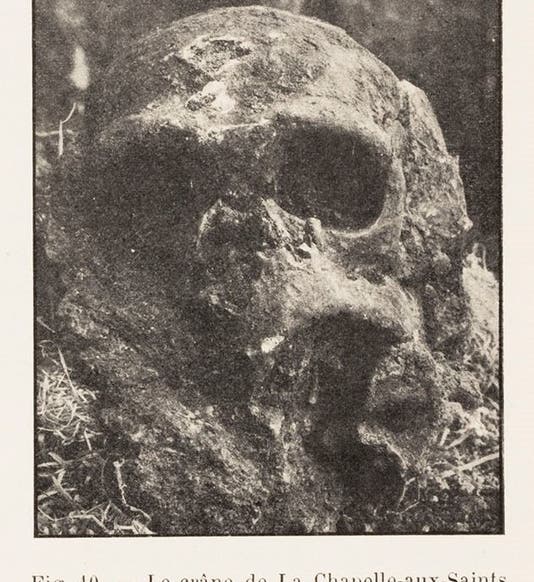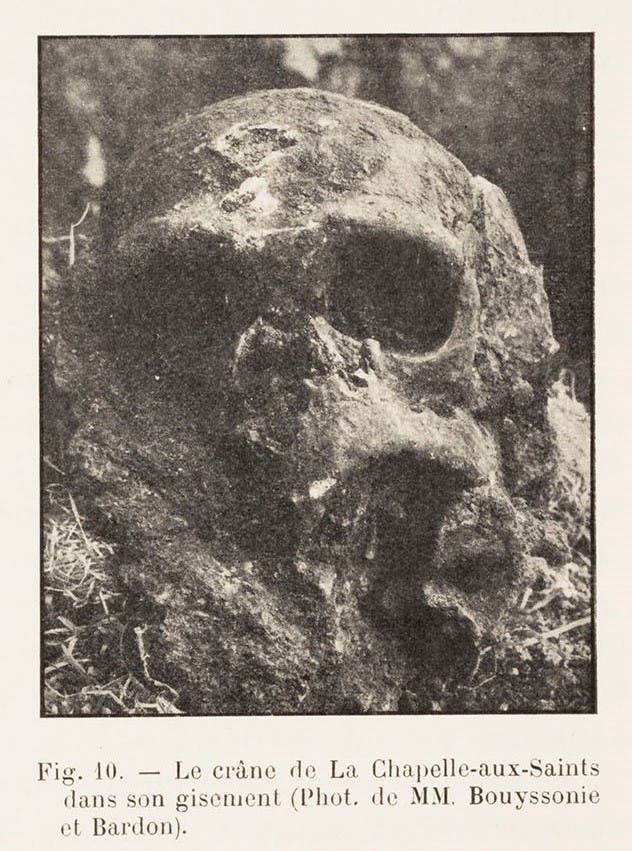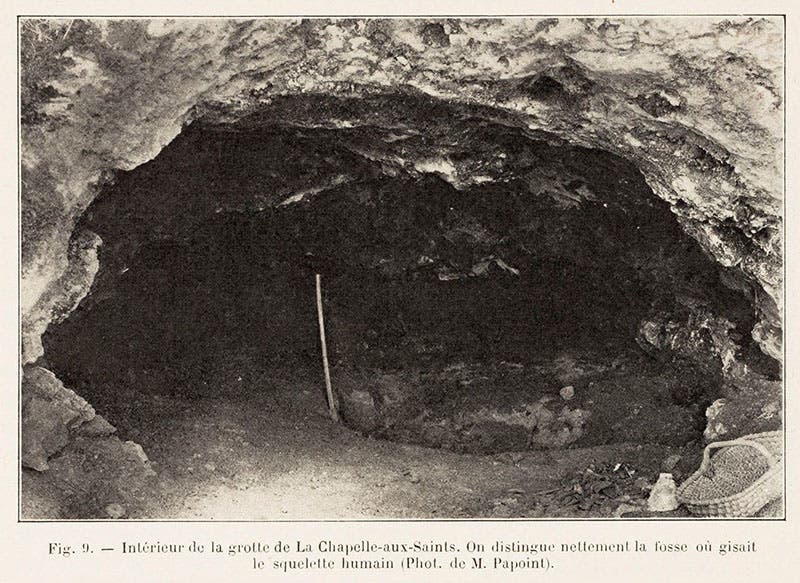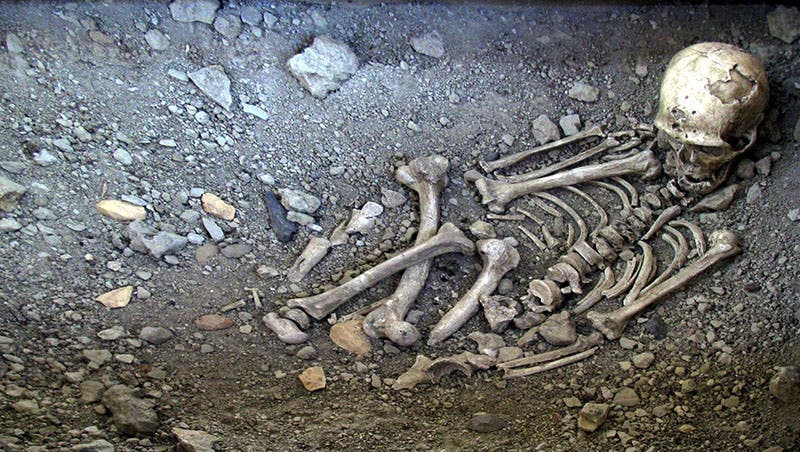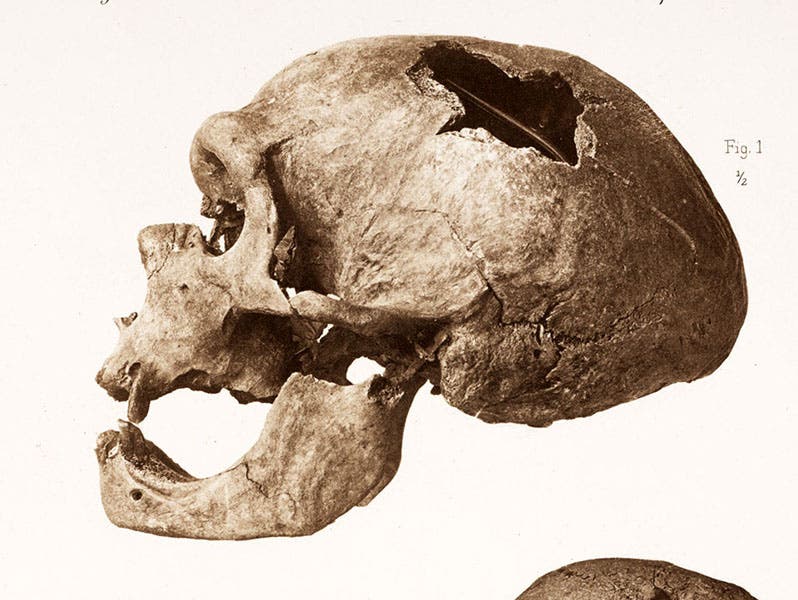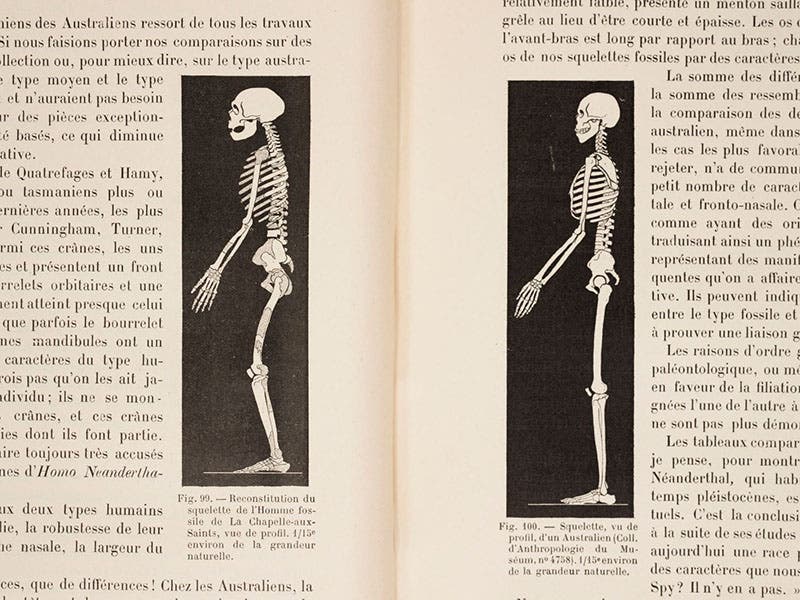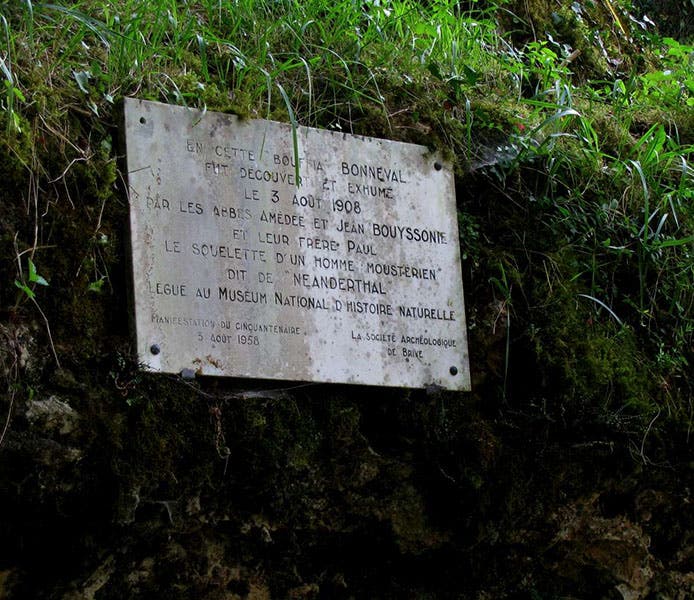Scientist of the Day - Old Man of La Chapelle-aux-Saints
On Aug. 3, 1908, a human-like skeleton of prehistoric age was discovered by three Catholic priests (two real brothers and a third lay brother) in a cave at La Chapelle-aux-Saints in France. La Chapelle-aux-Saints lies in the Corrèze department of south-central France; it is not too far from Lascaux, where the famous cave paintings would be found in 1940. The skeleton, which seemed to have been buried, was mostly complete, and (unusual for the time) photographs were taken of the find before excavation, from which the discovery site has been replicated (second image). The brothers, Amédée and Louis Bouyssonie, were friends with Marcellin Boule, director of the Institute of Human Paleontology in Paris, and they turned the skeleton over to him. Boule announced the discovery at a meeting of the Paris Academy of Sciences later that year, and then spent several years studying the remains, before publishing a lengthy monograph in 1911-13.
Boule determined that the "Old Man” of La Chapelle-aux-Saints, as he would be called, was a Neanderthal who had lived to be about 40, had lost most of his teeth, and died from a blow to the head. Moreover, he was a toolmaker, fashioning stone implements like those already found in the cave of Le Moustier, and called "Mousterian tools" (fifth image). Several other Neanderthal skulls had been discovered since the original Neanderthal was unearthed in 1856, but the find at La Chapelle-aux-Saints was the first with a near-complete skeleton and a full tool kit, and it dramatically confirmed that Neanderthal was a valid hominid type, and not a mélange of pathologically deformed modern humans, as others had suggested. Boule did not, however, believe that Neanderthals were human ancestors, but rather thought them to be an evolutionary dead-end.
Boulle’s monograph, "L'Homme fossile de La Chapelle-aux-Saints,” which was published in succeeding issues of Annales de Paleontologie beginning in 1911, has a number of large tinted lithograph plates of skeletal parts; several of which we displayed in our 2012 exhibition, Blade and Bone: The Discovery of Human Antiquity. You can also see these in an earlier post on Boule, which was however quite brief, as some of the early posts tended to be, suggesting that a fuller discussion today might be useful. An enlargement of a side view of the skull, as published in 1911, is included here (fourth image)
If you look up the Old Man of La Chapelle-aux-Saints on any of the usual websites, such as Wikipedia, you will nearly always find the statement that Marcellin Boule reconstructed the Old Man Neanderthal as stooped and forward-leaning, with a shuffling gait, a reconstruction not really justified by the evidence, but one that would prevail for the next 60 years, as all Neanderthals are depicted as primitive and stooped until the 1970s. If you search Google Image for "Marcellin Boule Neanderthal reconstruction" you will see hundreds of thumbnails of bow-legged, bent-over Neanderthals, and the blame for every one of them is laid at the feet of Boule. Even the Smithsonian Hall of Human Origins website, at which you can see yet another photograph of the famous skull, blames Boule for mis-representing Neanderthal.
But I wonder if Boule is really guilty as charged? There was an often-reproduced drawing of a reconstructed Neanderthal that appeared in L’Illustration in Paris in 1909, and again in the Illustrated London News shortly thereafter, drawn by Frantisek Kupka, but usually treated as if it were Boule’s own reconstruction (sixth image). I have never seen any documentation offered that Boule was responsible for Kupka’s drawing. In Boule’s own monograph, the only image that makes a comment on Neanderthal’s posture is a drawing of a standing “Old Man” skeleton, which is compared with that of an aboriginal Australian. The Neanderthal is slightly stooped, with bowed legs, but it hardly suggests the primitive half-human depicted by Kupka. Later depictions of Neanderthals, giving him a wild chimpanzee-like posture, go far beyond anything Boule suggested. If anyone is to blame, it should be Kupka.
The original site of the rock shelter at La Chapelle-aux-saints is open to visitors, but it is just a shallow rock shelter, with a pit where the skeleton was found. It is part of Le Musée de l'Homme de Néandertal in La Chapelle-aux-Saints. The skull and skeleton displayed there are high quality facsimiles. In 1958, a plaque was erected outside the cave in commemoration of the discovery, where you can verify that I did not just make up the date (eighth image). The name "Bouffia Bonneval" means the "limestone cave of the Bonnevals," referring to the family who owns the site. I understand that the discovery site was recently re-examined, since many had questioned the assertion by the brothers Bouyssonie that the body had been intentionally buried. It appears that the brothers were correct; these Neanderthals did indeed bury their dead.
As always in matters anthropological, if you would like to learn more about the “Old Man”, and see scads of original photos, maps, and plans, then hie thee to Don's Maps. There is also a fine map at this site that shows all the anthropological sites in south-central France, including La Chapelle-aux-Saints.
The original skeleton of the Old Man of La Chapelle-aux-Saints is on display at the Musée de l'Homme, Paris; I believe that it is part of the collections of the Muséum national d'Histoire naturelle in Paris.
William B. Ashworth, Jr., Consultant for the History of Science, Linda Hall Library and Associate Professor emeritus, Department of History, University of Missouri-Kansas City. Comments or corrections are welcome; please direct to ashworthw@umkc.edu.

